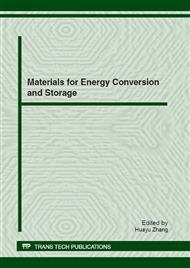p.137
p.142
p.147
p.152
p.156
p.160
p.164
p.169
p.174
Effect of Lithium Bis(oxalate)Borate-Based Electrolyte on the Performance of LiNi0.5Mn1.5O4 for High Voltage Lithium-Ion Batteries
Abstract:
LiNi0.5Mn1.5O4 is a promising 5 V class anode material for high power applications, however, before applying in lithium-ion batteries, it is necessary to find more appropriate electrolyte systems to exert the perfect electrochemical performance of LiNi0.5Mn1.5O4. In this paper, the electrochemical performances of LiBOB-propylene carbonate (PC)/dimethyl carbonate (DMC) electrolyte are investigated. It shows high oxidation potentials (>5.5 V) and satisfactory conductivities, When used in LiNi0.5Mn1.5O4/Li cells, compared to the cell with the electrolyte system of LiPF6-ethylene carbonate (EC)/dimethyl carbonate (DMC) electrolyte, LiBOB-PC/DMC electrolyte exhibit several advantages, such as more stable cycle performance, higher discharge voltage plateau (>4.64 V), higher coulomb efficiency, and higher mean voltage (4.55 V).
Info:
Periodical:
Pages:
156-159
Citation:
Online since:
July 2012
Authors:
Keywords:
Price:
Сopyright:
© 2012 Trans Tech Publications Ltd. All Rights Reserved
Share:
Citation:


